Home > About Us > Sustainability Management > Sustainability Report > Sustainability Report 2015 > Environmental Contributions in the fields of Materials, Machinery and Engineering
 Environmental Contributions in the fields of Materials, Machinery and Engineering
Environmental Contributions in the fields of Materials, Machinery and Engineering
The Kobe Steel Group offers a variety of products and technologies that contribute to environmental conservation, including ones related to energy conservation and renewable energies.
Contributing to the environment through the pursuit of monozukuri (manufacturing) is KOBELCO's mission.
Effective Use of Resources
![]()
New Hot-metal Treatment Plant at Kakogawa Works Goes into Operation
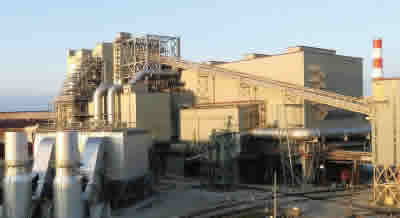
New hot-metal treatment plant
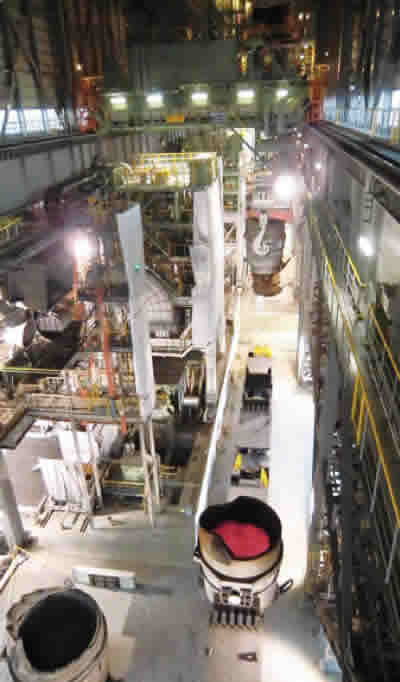
Kanbara reactor
Kobe Steel has constructed a new hot-metal treatment plant, which began operating in April 2014, at Kakogawa Works. The new plant was developed with the aim of upgrading production systems to achieve further expansion in sales of the company's "Only One" products in the steel products business, while making them more cost competitive.
The hot-metal treatment process removes sulfur and phosphorus impurities from molten iron, and is essential for producing Kobe Steel's "Only One" products, such as special steel wire rods and bars, automotive high-strength steel sheets, and steel plates for the energy sector, given the high degree of cleanliness required to manufacture such products. The new hot-metal treatment plant has two Kanbara reactors for desulfurization and one dephosphorization furnace. Used in conjunction with existing facilities, the new plant makes it possible for Kobe Steel to process nearly its entire volume of molten iron, thereby enabling the company to further increase its capacity for producing its "Only One" products.
The new hot-metal treatment plant increases reaction efficiency of desulfurization in the Kanbara reactors and dephosphorization in the dephosphorization furnace, thereby reducing consumption of auxiliary materials and improving yield.
Reducing the Weight of Railway Cars
![]()
Delivery of Aluminum Extrusions to Hitachi for UK Trains
Kobe Steel has begun delivering aluminum extruded shapes to Hitachi's Kasado Works for use in railway car bodies built for the Intercity Express Programme (IEP) in the United Kingdom, after having received the order from Hitachi Group company Hitachi Rail Europe Ltd. to supply nearly the total volume necessary to build the fleet of trains.
Kobe Steel's aluminum extrusions are manufactured at Chofu Works in Shimonoseki, Yamaguchi Prefecture, which is capable of making a variety of aluminum shapes. Kobe Steel contributes to making trains more efficient by helping to reduce overall train weight through the use of aluminum extrusions in railway cars. Working in conjunction with rolling stock manufacturers, Kobe Steel develops and supplies extruded shapes that help ensure safety and quieter train operation.
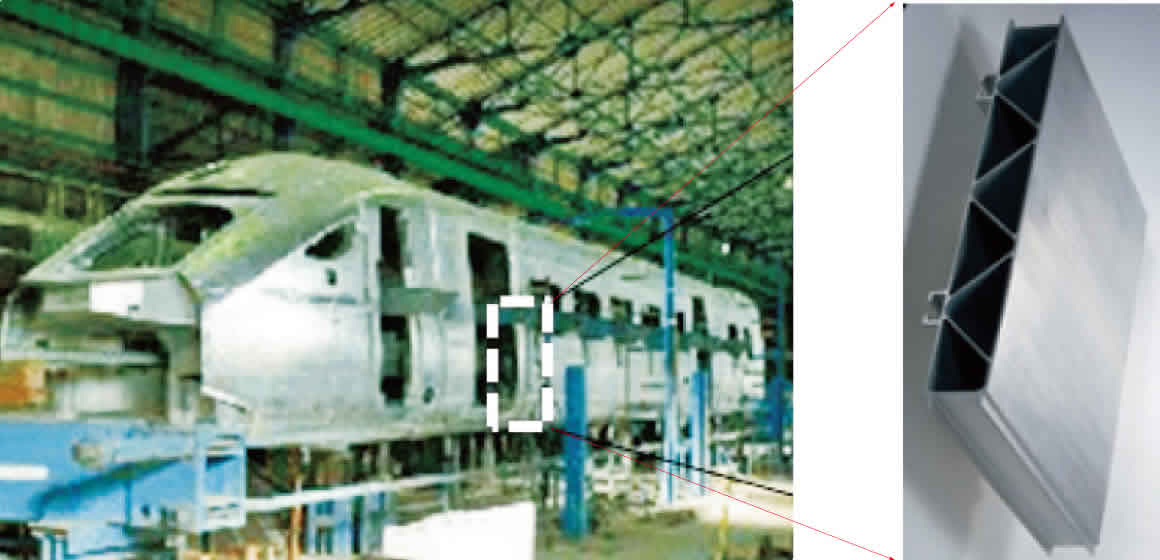
|
Side view of railway car (photo courtesy of Hitachi, Ltd.) |
Aluminum extrusion |
Aluminum Honeycomb Panels Used in Hokuriku Shinkansen
Shinko-North Co., Ltd. is a manufacturer of aluminum honeycomb panels that consist of an aluminum honeycomb inner core sandwiched between two aluminum cover sheets.
The panels are low in weight yet have high strength and excellent stiffness due to their honeycomb structure, 97 percent of which consists of air due to the core's design containing multitudes of contiguous hexagonal honeycomb structures. The honeycomb panels weigh roughly one-fifth as much as standard aluminum panels and roughly one-tenth as much as steel sheet, at equivalent levels of rigidity.
Honeycomb panel demand has been increasing year after year for applications in a wide range of different fields. The aluminum honeycomb panels manufactured by Shinko-North are being used in constructing the floor sections of the E7 and W7 series Shinkansen which is operating on the Hokuriku Shinkansen Line.
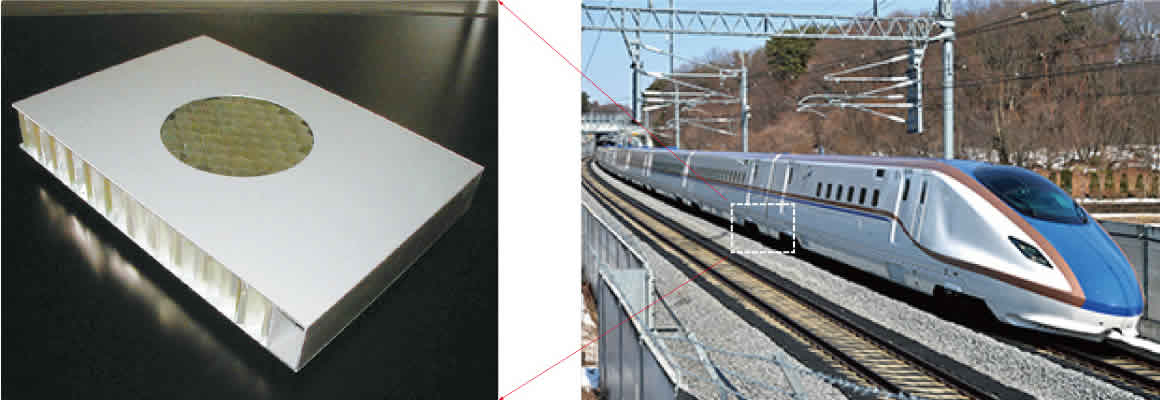
|
Aluminum honeycomb panel |
E7 series Shinkansen |
Growing Use of Renewable Energy
![]()
Hybrid Binary Power Plant Goes into Operation
Toshiba Corporation and Kobe Steel have wrapped up construction of a test facility consisting of a binary power generation system that uses wind power, solar thermal energy and biomass as heat sources. The facility, built as a subsidy project under Japan's Ministry of the Environment, is now in the trial operation phase. The binary power generation system now in operation produces electricity through turbines driven by steam which is created by heating a liquid with a low boiling point using the combined renewable heat energy sources of wind power, solar thermal energy and biomass.
Kobe Steel is overseeing development of the binary power generation system operated using steam which is produced by solar thermal collectors and wood biomass boilers. On the basis of the technologies that have emerged from the test facility now undergoing trial operation, Toshiba and Kobe Steel are contributing to the more widespread use of renewable energy sources by developing equipment used in supplying electricity and heat energy in close contact with local communities. At the same time, the companies are keeping with the "local production of energy for local consumption" concept while taking into account energy needs should a disaster strike.
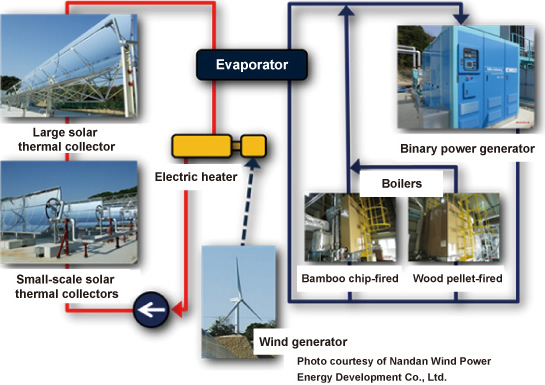
Binary power generation system
Reducing CO2 Emissions of Ships
![]()
Kobe Steel embarks on development of binary power generation system for ships

MV Asahi Maru
(photo courtesy of Asahi
Shipping Co., Ltd.)
Kobe Steel and Asahi Shipping Co., Ltd. have started developing a binary power generation system for marine vessels. We aim to conclude development in fiscal 2015 and equip vessels with the new system in fiscal 2016.
The new binary power generation system will act as an auxiliary source of electric power for propelling ships, produced using a binary power generator that draws on a ship's heat discharge which had gone largely unutilized in the past. By making effective use of this energy source, vessel operators will be able to cut fuel consumption and CO2 emissions by some 2.6 percent to 2.9 percent per annum, according to estimates.
These development efforts will enable Kobe Steel to come up with new binary power generators for marine vessels. Asahi Shipping is in charge of overall construction of the power systems and will equip the MV Asahi Maru, a large, company-owned coal carrier that serves Kobe Steel, with the newly developed binary power generator.
Attaining Lower Exhaust Emissions, Noise Levels and Fuel Consumption
![]()
Kobelco Cranes launches wheel crane boasting new safety features and a large operating range
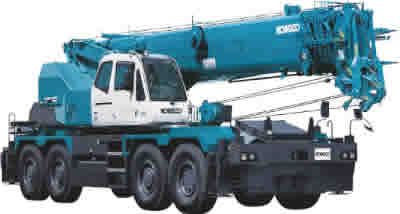
PANTHER 700
On March 5, 2015, Kobelco Cranes Co., Ltd. launched Japanese domestic market sales of its PANTHER 700 (RK700-2) rough terrain crane featuring a maximum lifting capacity of 70 tons.
The PANTHER 700 is a high-power wheel crane boasting new safety features and an expansive operating range. We have managed to create a crane that offers excellent safety performance even at considerable heights and is capable of operations within constricted spaces. The crane is also noted for low emissions, decreased noise levels and reduced fuel consumption. Kobelco Cranes is forging ahead in bolstering its lineup of crawler cranes and wheel cranes with the aim of better addressing customer needs.
Heightening Productivity of Euglena (Microalgae) Cultivation
![]()
Kobelco Eco-solutions begins study into commercialization of euglena for applications such as food products and cosmetics using closed reactor unit
Kobelco Eco-Solutions Co., Ltd. has begun full-scale efforts involving cultivation of Euglena1 microalgae using a 1m3 closed reactor unit installed at its facilities. As a result, the company is now able to supply biomass derived from Euglena by the kilogram and has launched a study into commercial applications of the microalgae such as for foodstuffs, cosmetics and chemical products.
There are two general methods of culturing Euglena: photosynthetic cultivation and heterotrophic cultivation2. In comparison with photosynthetic cultivation, Kobelco Eco-Solutions' method of heterotrophic cultivation in a closed reactor results in a yield of several hundred times the amount of biomass per unit area, and makes it possible to maintain consistent cultivation of Euglena unaffected by sunlight, temperature and other climatic factors of the external environment.
Kobelco Eco-Solutions plans to keep improving its cultivation methods while accumulating cultivation data using the 1m3 reactor.
1. Euglena is a unique organism with plant-like qualities that enable photosynthesis, but is also capable of animal-like undulating motion.
2. Heterotrophic cultivation is a cultivation method that uses organic compounds as the source of carbon for organisms.


